I know what you’re thinking…Shea Stadium…Radio City Music Hall? Is he running out of Forgotten places to root around in? Not even close. The modus operandi of FNY, besides finding places in New York where the buses don’t run and that the guidebooks don’t list is also to provide Forgotten aspects to eminently familiar NYC icons and attractions. That’s why I eagerly signed up for the Radio City exploration on Open House NY weekend, October 4-5, 2008.
Why, I hadn’t been in the NY showbiz mecca since April 1968, when I was trundled off with mother and father to see the latest Disney vehicle, The Love Bug, about an intelligent Volkswagen and starring Dean Jones and Buddy Hackett.
Architect Hugh Hardy, whose firm H3 completely restored RCMH to much of its past glories in 1999, led the tour. He explained that when the theater first opened, it was the child of many fathers: the Rockefellers, RCA honcho David Sarnoff, and the Roxy Theater’s Samuel “Roxy” Rothafel. Originally it was conceived as a vehicle to bring “serious” entertainment back to NYC as a rebuff to honky-tonks, vaudeveille and burlesque. Opening night featured Ray Bolger and the Martha Graham dance company. The ‘high-class’ concept flopped and the next year, RCMH converted to the format that would serve it well for many years: a feature film combined with a stage show starring the leggy Rockettes, originallly known as the Roxyettes since they got their start at the Roxy. The Christmas Show, as well, has been a staple ever since the earliest days. The RCMH’s Wurlitzer organ was the largest ever built for a movie theater; the “Great Stage” ‘s elevators were so advanced that the US Navy copied its hydraulics while constructing aircraft carriers during World War II.
Each level of Radio City Music Hall contains a pair of men’s and women’s lounges, pretty much rooms where men would relax and smoke, and women would put on makeup and smoke. Interior designer David Deskey provided a different look for each. The mural in the gentlemen’s lounge here is calledMen Without Women, a description of the lounge’s atmosphere. The Picasso-esque work was produced by Stuart Davis, who specifically named it for ashort story by Ernest Hemingway. Recognizable in the image are two barber poles, playing cards, a sailboat, an abstract gas pump, a pack of cigs, a pipe and matches. The mural hung at the Museum of Modern art between 1975 and 1999, when it was returned as part of RCMH’s restoration.
Your webmaster’s eye was drawn to William Zorach’s sculpture Spirit of the Dance (Rhythm). The work is nine-feet tall but since it is made of aluminum, it’s relatively light. It is one of two statues by Zorach that, after they were originally installed, were removed during the buttoned-down decades that followed for being risqué.
The bathrooms at RCMH are sumptuous.
The women’s lounge on the same floor features the mural The History of Cosmetics, a 1932 mural by Witold Gordon. Egyptian, Chinese, medieval and modern women are depicted being gifted with, or applying makeup. Gordon’s work could often be found on the cover of The New Yorker in the 1940s.
Donald Deskey (1894-1989) designed much of the Rado City Music Hall interior, as well as the distinctive chairs, cabinets, and interior furniture in an Art Moderne vein, popular in the early 1930s. Hugh Hardy was quck to mention that RCMH was not designed in Art Deco, which was considerably more ornate than its streamlined Moderne successor.
Deskey took on many professional personas throughout the 1930s and 1940s, as a furniture, interior, graphic and industrial designer. He created objects as diverse as pianos, clocks, radios, slot machines, and industrial laminates. After settling down in New York he established a design consulting firm and partnered with Phillip Vollmer soon after to start Deskey-Vollmer, a company geared more towards furniture and textile design. The result of this arrangement was that Deskey produced a number of pieces of furniture, although many of them were made for a specific space and client. Among his high profile commissions were John D. Rockefeller’s Manhattan apartment and, on a larger scale, the interiors of Radio City Music Hall, executed in 1932-33. Deskey won the chance to design the latter in a competition, his proposal promising a modern theater to best the opulent movie palaces of the period. His lush deco interior proved perfect. He also designed the window displays for many of the 5th Avenue department stores, using screens he fabricated in linoleum, cork and bakelite. Moderne Age
[In] 1958 Armand D’Angelo, Commissioner of Water Supply, Gas and Electricity, announced that the city’s rather anarchic collection of 64 varieties of lampposts, a total of 110,000, would be phased out in favor of a modern one, the Cobra head, designed by Donald Deskey. Christopher Gray, NYTimes
Radio City Music Hall’s elevators are wood-paneled with scenes from classic myths.
The metal doors that lead to the main auditorium and the Great Stage feature bas reliefs like this one depicting flamenco dancers.
The 2nd floor women’s lounge is in beige and green, as is the adjoining restroom.
Whole lotta smokin’ goin’ on! Another men’s lounge is decorated with The History of Nicotine (The Life of Saint Nicotine) by Deskey himself, imprinted on aluminum foil. The mural was requested by the R. J. Reynolds Tobacco Company, which was looking for uses for one of its products — the aluminum foil that appears in cigarette packs.
Elsewhere in OHNYville
Stopped off in the Chrysler Building lobby, ordinarily closed off to shutterbugs, and saw its incredible elevator doors (would like to get inside one sometime) as well as an incredibly large (110′ x 76′) ceiling mural, Transport and Human Endeavor, by Edward Trumbull, whose signature can be seen above.
[It] depicts energy and man’s application of it to the solution of his problems. The mural’s central image is a male figure who was described in a 1930s building brochure as a ”muscled giant whose brain directs his boundless energy to the attainment of the triumphs of this mechanical era.” There are images of fire, lightning, electricity, heat and steam, the telegraph, telephone, radio, ocean liners, trains, airplanes, buildings, and scenes of construction workers building the Chrysler building and from the Chrysler assembly line. In the 1970s, the mural was essentially damaged by the application of a polyurethane coating; in addition, recessed lighting was cut into the mural itself. In 1999, a thorough restoration was done with an estimated 10,000 hours of labor. The urethane was removed; the spotlight fixture holes repaired – filled with plaster, new canvas attached and images recreated using archival photos. New York Daily Photo
The security guard told me that he believed that whites were shown on one side of the mural and blacks on the other, and though I wouldn’t think that was a stretch in the segregated Dirty Thirties, I didn’t see anything on the mural that’d make that undoubtedly clear.
Bob Mulero, king of all lampposts, works for the MTA at Grand Central Terminal. As a shortcut he led me through an unheralded passageway to West 44th Street, and I was amazed to see what appeared to be original interlocking Guastavino tilework. An amazing discovery!
10/16/08

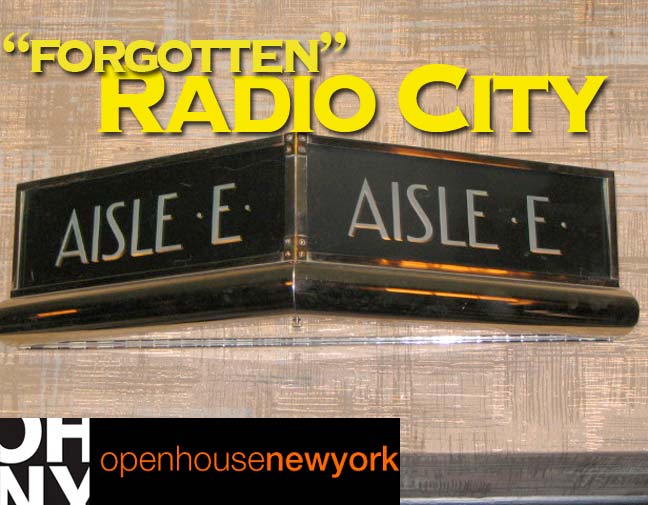









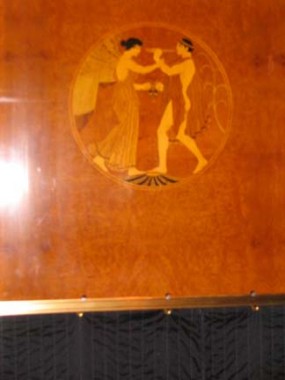




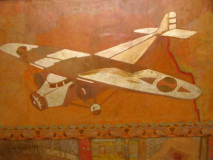
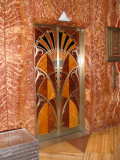
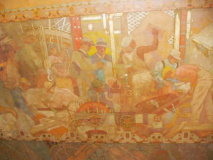
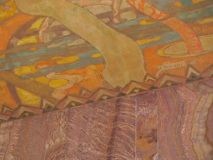


5 comments
I think you may have Ray Bolger confused with someone else – he was always a comic dancer, and by 1932 had appeared in leading roles in several Broadway shows; I’ve never heard of him playing the piano as any part of his act.
Love the work you do on this site.
Dwight
You’re right. I had him confused with Victor Borge. I removed the description.
I still see Ray Bolger’s name there.
Thank you for the information on the women’s lounge. That information is almost impossible to find even though it is oddly one of the most popular rooms in Radio City. I wish there was more information out there on the murals in the women’s lounge.
Do you have any photographs of the mural by eduard Ulreich in this building? I believe it is the men’s lounge on the third floor. I am researching him for an art history class. I love your web site and will follow it. I come to NYC once a year and am always looking for forgotten aspects. Thanks.